|
|

|
  
Features
Update 2020/7/30 Ocean Exploring
PROTEUS™: A SPACE STATION UNDER THE SEA FOLLOWING IN THE FOOTSTEPS OF JACQUES COUSTEAU
By Suzanne Forcese
“People protect what they love, they love what they understand, and they understand what they are taught.”--Jacques-Yves Cousteau
Although the oceans represent over 99% of our world’s living space (332 million cubic miles), only 5% has been explored to any significant degree. The ocean has created and sustained life as we know it, with the leading source of oxygen, fresh water and nourishment – as well as employment opportunities in trade, tourism and travel. Whether we are conscious of it or not, the ocean dictates our trajectory – everywhere, every day.
Ocean awareness has the capacity to address humanity’s most pressing concerns: medical discoveries, food sustainability, sustainable energy, and the impacts of climate change.
PROTEUS™, the vision of renowned aquanaut, Ocean explorer, environmentalist, Fabien Cousteau, (Fabien Cousteau Ocean Learning Centre--FCOLC), will become the world’s most advanced underwater research station and habitat.
| 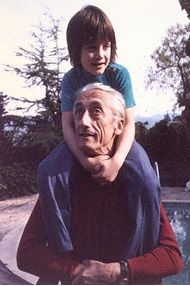
Young Fabien with his Grandfather
(Photo courtesy FCOLC) |
The goal is to offer global collaboration amongst the world’s leading researchers, academics, government agencies and corporations to give rise to scientific breakthroughs.
The first grandson of the late Jacques-Yves Cousteau, has partnered with designer Yves Behar (Fusepoint); Northeastern University; Rutgers University; and the Caribbean Research and Management of Biodiversity Foundation.
|
WATERTODAY had the privilege of connecting with Fabien Cousteau and two leading researchers from Northeastern, Dr. Mark Patterson and Dr. Brian Helmuth who are advising on the scientific program for PROTEUS.
“There wasn’t pressure placed on me to follow in the family finsteps,”Fabien Cousteau told WT.
“Growing up diving, starting at the age of 4, and then taking adventures on the Calypso made for the most incredible classroom. I learned so much from my grandparents and the other crew members.
|
“Today I maintain the same wonder I had as a kid. I’m still in awe of observing everything that the ocean has to offer and teach us.
As I continue to learn and discover more I keep in mind my grandfather’s quote:
People protect what they love, they love what they understand, and they understand what they are taught.” | 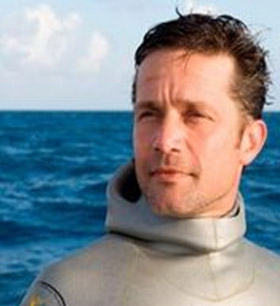
Fabien Cousteau |
Jacques Cousteau also left an indelible imprint on both Dr. Mark Patterson and Brian Helmuth, of Marine and Environmental Sciences, Northeastern University.
“Six years ago,” Patterson told WT in a telephone conversation, “we got to know Fabien during Mission 31 on Aquarius, the underwater research station off the Florida Keys. It was an absolute blast being with the grandson of the man who inspired me to become an aquanaut and devote my life to marine science.”
The goal of Mission 31 was to break Jacques Cousteau’s 30 day underwater record. Fabien did so spending 31 days on Aquarius with the science team where 3 years of equivalent research was performed in a month resulting in 12 published scientific studies and 9,800 scientific articles.
Named after the primordial deity in Greek mythology, the “protector of the seas and keeper of knowledge”, Cousteau says, “PROTEUS was very much a 3 A.M. in-the-morning dream. After visiting Dr. Sylvia Earle (fondly known as ‘Her Deepness’) on Aquarius and then leading Mission 31 there in 2014, I saw that more was needed to accommodate aquanauts for longer – and that more could be done to address additional needs that come with underwater living.”
|
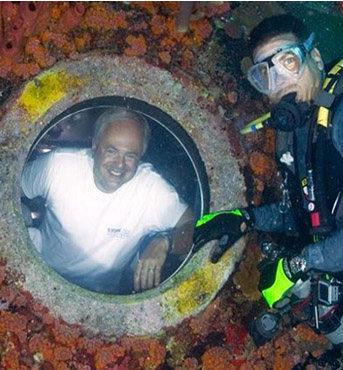
Mark Patterson looking out of Aquarius - Mission 31 |
Patterson adds that ocean exploration and research from PROTEUS will enable aquanauts to put in 12 -15 hour/ day and night work. “Scuba dives seriously limit us. We can only do 1 or 2 dives a day and it’s difficult to focus on our work when we are constantly worried about time and running out of oxygen.
“I am hoping I can live for 2 months on PROTEUS. I could accomplish 5 years’ worth of work.” Patterson hopes to test advanced sensors and underwater robots developed in his lab.
|
PROTEUS™ will house state-of-the-art labs with the latest equipment – freezers, microscopes, and technology, sleeping quarters and a moon pool—allowing for up to 12 occupants to complete years’ worth of research in days. A first-ever full-scale video production facility to provide continuous live streaming delivery of augmented virtual reality to collaborators world-wide has been included in the design concept of Yves Behar. The habitat which will be located off the coast of Curacao at a depth of 60 feet (3 atmospheres) in the richly biodiverse waters in a marine protected area will be sustainably powered by hybrid sources including wind, solar and Ocean Thermal Energy Conversion (OTEC).
Fabien Cousteau says, “PROTEUS will be around eight times the size of Aquarius and address a range of challenges that come with underwater living, such as cooking. You can’t cook with open flames under water.”
“PROTEUS will have the first underwater greenhouse which will allow us to grow fresh produce,” Cousteau adds.
Considering that living underwater 3 times the calories are burned compared to land life, Patterson says that will be a welcome addition. Fresh produce was what the aquanauts missed most on Aquarius.
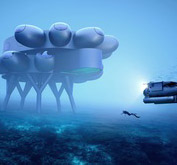
PROTEUS™ will be 4000 sq ft and built in modules so that additional space can be added in the future.
The spiral architecture design created by Yves Behar is meant to inspire
the same passion for ocean exploration as we have for space exploration.
Following in the finsteps of both his grandfather and film producer father, Jean- Michel Cousteau, Fabien also focuses on the power of education.
“What empowers so many of my decisions is making a better planet for our youth to grow up in. PROTEUS will contain a state-of-the-art production studio, which will allow us to create incredible videos onsite and livestream with classrooms across the globe. On Mission 31, we connected with over 100,000 students on all continents – and PROTEUS will be able to expand on that outreach.”
|
Educational outreach is also paramount to Brian Helmuth, Professor at Northeastern ‘s Marine Science Center in Nahant, where his research and teaching focus on the impacts of global climate change on marine ecosystems worldwide. He has been an aquanaut on several saturation missions in the Aquarius. “There’s a misperception that all knowledge is known,” Helmuth says, whose career in marine biology was also inspired by Jacques Cousteau.
“There’s a huge need for young people to reconnect with the environment.”
| 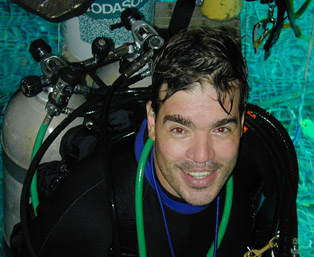
Brian Helmuth
|
“Aquarius was the genesis for PROTEUS. We started to ask questions. So many environmental problems that can be solved by research have to involve people impacted by problems. So what would it take to do this right?”
Helmuth who will be looking at the effects of climate change on biodiversity and sustainable food production while on PROTEUS says, “We can give kids across the globe a sense of place with virtual reality.”
As the ocean warms, marine bacteria, viruses and fungi thrive which increases the likelihood that marine life and humans will be exposed to novel diseases. The ability to sample and access more and varied types of marine life is critical to the development of new biopharmaceuticals.
“We are running out of rain forest where we have been sourcing biopharmaceuticals. Microbiological warfare has been going on for millions of years between sea creatures. What compounds are they using that we could be using as drugs?” Patterson asks, “For example, sharks don’t get cancer. What can we learn from them?”
For the last decade, Patterson’s lab has been developing Autonomous Underwater Vehicles (AUV’s), free-swimming robots that survey the bottom and water column. “Robots will be able to travel farther than the aquanauts and they can work 24/7.” There will be a robot garage where they can be charged.
The threat of microplastics on zooplankton and phytoplankton will also be studied. “Alarmingly, plankton are preferring the microplastics to their natural food sources.” This is of concern as phytoplankton provide the earth with oxygen.
Patterson, who was involved in the Jason Project which connected astronauts on the International Space Station to aquanauts on Aquarius, compares the underwater habitat experience with the emotions that astronauts experience when they look at the earth from a space perspective.
“It transforms one in the most unimaginable and emotional way. It is always a bitter sweet moment returning to land that brings me to tears. When I look at a drop of water and realize all the microscopic organisms that have a role in our existence and then look to the whole ocean and all the marine life that we have so much to learn from, I realize how connected we all are on this planet and how we need to race to clean up our messes.” -- Dr. Mark Patterson
suzanne.f@watertoday.ca
|
|
|
Have a question? Give us a call 613-501-0175
All rights reserved 2025 - WATERTODAY - This material may not be reproduced in whole or in part and may not be distributed,
publicly performed, proxy cached or otherwise used, except with express permission.
|
| |